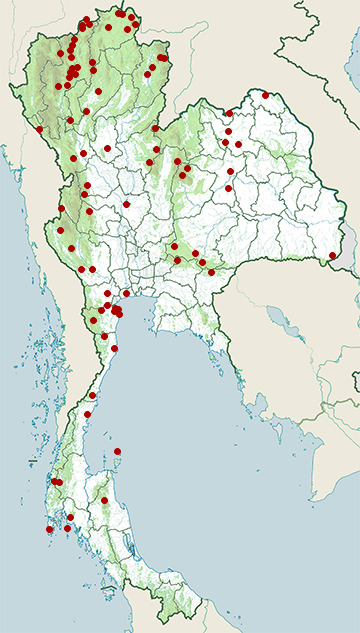Species of Thailand
Himalayan swiftlet
Aerodramus brevirostris
Thomas Horsfield, 1840
In Thai: นกแอ่นพันธุ์หิมาลัย
The Himalayan swiftlet (Aerodramus brevirostris) is a small swift. It is a common colonial breeder in the Himalayas and Southeast Asia. Some populations are migratory.
This swiftlet was formerly placed in the genus Collocalia. Two of its five subspecies are frequently given full species status, A. b. rogersi as the Indochinese swiftlet, Aerodramus rogersi, and the isolated Javan form A. b. vulcanorum as the Volcano swiftlet, Aerodramus vulcanorum.
Description
This 13–14 cm long swiftlet has swept-back wings that resemble a crescent or a boomerang. The body is slender, and the tail is forked. It is, in many respects, a typical swift, having narrow wings for fast flight, and a wide gape and small beak surrounded by bristles for catching insects in flight. Its legs are very short, preventing the bird from perching, but allowing it to cling to vertical surfaces.
It is mainly grey-brown above and paler brown below. It has a pale grey rump and a pale patch above and behind the bill. The sexes are similar, but the juvenile has a less distinct rump.
There are five subspecies, differing mainly in the rump tone.
- A. b. brevirostris breeds in the Himalayas east to Bangladesh, Myanmar and Thailand. This, the nominate race, is an altitudinal migrant, breeding up to above 4, 500 m, but wintering between 900 and 2750 m altitude.
- A. b. innominata breeds in central China, and winters in southwestern Thailand and the Malay Peninsula. The rump is slightly darker grey than nominate brevirostris
- A. b. inopina breeds in southwestern China. This is the darkest-rumped race.
- A. b. rogersi the Indochinese swiftlet, breeds in eastern Myanmar, western Thailand and Laos. This is a small, pale-rumped race.
- A. b. vulcanorum the volcano swiftlet, breeds in Java, Indonesia on volcanic peaks. It has dark underparts and an indistinct pale grey rump.
Over much of its range, this is the only swift, but in the south of its breeding area and much of its wintering range it can be very difficult to distinguish this species from other Collocalia swiftlets.
Voice and echolocation
The Himalayan swiftlet has a twittering roosting call, and also has a piercing call.
What distinguishes many, but not all, swiftlet species from other swifts and indeed almost all other birds (the oilbird being an exception) is their ability to use a simple but effective form of echolocation to navigate through the darkness of the caves where they roost at night and breed. With the present species, at least vulcanorum is known to echolocate.
Unlike bats, the swiftlets make clicking noises for echolocation that are well within the human range of hearing. Two broadband pulses are separated by a slight pause. The length of the pause shortens as light becomes poorer. The clicks are followed by the twittering call when the bird is approaching its nest.
Echolocation was used to separate the former genus Aerodramus, which was thought to contain the only echolocating swiftlets. from Collocalia, but the discovery that the pygmy swiftlet, Collocalia troglodytes, also echolocates led to some taxonomists merging the two genera.
Behaviour
This swiftlet is a highland species, with a preference for feeding open areas in forests, such as river valleys. A. b. brevirostris breeds up 4, 500 m in Nepal and 2200m in central Bhutan, and the forms A. b. rogersi and A. b. inniminata occur up to 2200 m in Thailand.
The tiny cup nest is constructed by the male swift from thick saliva and some moss, and is attached to a vertical rock wall in a cave. Nests of this colonial swift may be touching. The clutch is two white eggs. This swiftlet is monogamous and both partners take part in caring for the nestlings.
The Himalayan swiftlet, like all swifts, is an aerial insectivore, leaving the cave during the day to forage, and returning to its roost at night. In the evening or bad weather, flocks may descend from the hills to feed over cultivated land. This gregarious species forms flocks typically of about 50 birds, but up to 300 have been recorded. Its flight is mainly gliding due to very long primary feathers and small breast muscles.
Status
This species is common and widespread, but the volcano swiftlet, if considered a separate species, is near-threatened. It occurs only on active volcanos in Java, with four definite sites and five likely but unconfirmed sites. Birdlife International estimates a total of under 400 birds for the known localities. Since this form nests in crater crevices, and all known localities are active volcanoes, colonies are believed to be susceptible to periodic extinction.
This article uses material from Wikipedia released under the Creative Commons Attribution-Share-Alike Licence 3.0. Eventual photos shown in this page may or may not be from Wikipedia, please see the license details for photos in photo by-lines.
Category / Seasonal Status
Wiki listed status (concerning Thai population): Breeds in highlands, winter visitor elsewhere
BCST Category: Recorded in an apparently wild state within the last 50 years
BCST Seasonal statuses:
- Non-breeding visitor
- Resident or presumed resident
Scientific classification
- Kingdom
- Animalia
- Phylum
- Chordata
- Class
- Aves
- Order
- Apodiformes
- Family
- Apodidae
- Genus
- Aerodramus
- Species
- Aerodramus brevirostris
Common names
- Thai: นกแอ่นพันธุ์หิมาลัย
Subspecies
Aerodramus brevirostris brevirostris, Thomas Horsfield, 1840
Range: Breeds in the Himalayas east to Bangladesh, Myanmar and Thailand. This, the nominate race, is an altitudinal migrant, breeding up to above 4, 500 m, but wintering between 900 and 2750 m altitude.
Aerodramus brevirostris innominata, Allan Octavian Hume, 1873
Range: Breeds in central China, and winters in southwestern Thailand and the Malay Peninsula. The rump is slightly darker grey than nominate brevirostris
Aerodramus brevirostris inopina, Outram Bangs, 1909
Range: Breeds in southwestern China. This is the darkest-rumped race.
Aerodramus brevirostris rogersi, Herbert Girton Deignan, 1955
Common name: The Indochinese swiftlet
Range: Breeds in eastern Myanmar, western Thailand and Laos. This is a small, pale-rumped race.
Aerodramus brevirostris vulcanorum, Erwin Stresemann, 1926
Common name: The volcano swiftlet
Range: Breeds in Java, Indonesia on volcanic peaks. It has dark underparts and an indistinct pale grey rump.
Synonyms
- Collocalia brevirostris, Herbert Girton Deignan (1955)
Conservation status

Least Concern (IUCN3.1)
Photos

Range Map

- Ban Laem District, Phetchaburi
- Ban Phai District, Khon Kaen
- Bang Saphan Noi District, Prachuap Khiri Khan
- Bueng Boraped Non-Hunting Area
- Chae Son National Park
- Chiang Dao District, Chiang Mai
- Chiang Dao Wildlife Sanctuary
- Chiang Khong District, Chiang Rai
- Chiang Saen District, Chiang Rai
- Doi Chong National Park
- Doi Inthanon National Park
- Doi Lang
- Doi Lo District, Chiang Mai
- Doi Pha Hom Pok National Park
- Doi Phu Kha National Park
- Doi Suthep - Pui National Park
- Fang District, Chiang Mai
- Hua Hin District, Prachuap Khiri Khan
- Huai Kha Khaeng Wildlife Sanctuary
- Huai Nam Dang National Park
- Kaeng Krachan National Park
- Khao Dinsor (Chumphon Raptor Center)
- Khao Laem National Park
- Khao Luang National Park
- Khao Sam Roi Yot National Park
- Khao Sok National Park
- Khao Yai National Park
- Khao Yoi District, Phetchaburi
- Khlong Lan National Park
- Khon San District, Chaiyaphum
- Khun Chae National Park
- Khun Nan National Park
- Khun Tan District, Chiang Rai
- Kumphawapi District, Udon Thani
- Kut Thing Non-Hunting Area
- Laem Pak Bia
- Mae Ai District, Chiang Mai
- Mae Moei National Park
- Mae Ping National Park
- Mae Rim District, Chiang Mai
- Mae Taeng District, Chiang Mai
- Mae Wong National Park
- Mueang Chiang Mai District, Chiang Mai
- Mueang Chiang Rai District, Chiang Rai
- Mueang Kanchanaburi District, Kanchanaburi
- Mueang Khon Kaen District, Khon Kaen
- Mueang Krabi District, Krabi
- Mueang Lampang District, Lampang
- Mueang Nan District, Nan
- Mueang Nong Khai District, Nong Khai
- Mueang Phetchaburi District, Phetchaburi
- Mueang Phuket District, Phuket
- Mueang Ratchaburi District, Ratchaburi
- Mueang Samut Sakhon District, Samut Sakhon
- Mueang Sukhothai District, Sukhothai
- Mueang Tak District, Tak
- Mueang Udon Thani District, Udon Thani
- Nam Nao National Park
- Nong Bong Khai Non-Hunting Area
- Nong Ya Plong District, Phetchaburi
- Op Khan National Park
- Pak Chong District, Nakhon Ratchasima
- Pak Thale
- Pang Sida National Park
- Pha Daeng National Park
- Phi Phi Islands
- Phu Chong Na Yoi National Park
- Phu Foi Lom National Park
- Phu Hin Rong Kla National Park
- Phu Khiao Wildlife Sanctuary
- Phu Suan Sai National Park
- Sai Yok District, Kanchanaburi
- Sakaerat Environmental Research Station
- San Sai District, Chiang Mai
- Sri Nakarin Dam National Park
- Sri Phang Nga National Park
- Taksin Maharat National Park
- Tham Sakoen National Park
- Than Sadet - Koh Pha-Ngan National Park
- Thap Lan National Park
- Thung Salaeng Luang National Park
- Thung Yai Naresuan Wildlife Sanctuary
- Wiang Kaen District, Chiang Rai